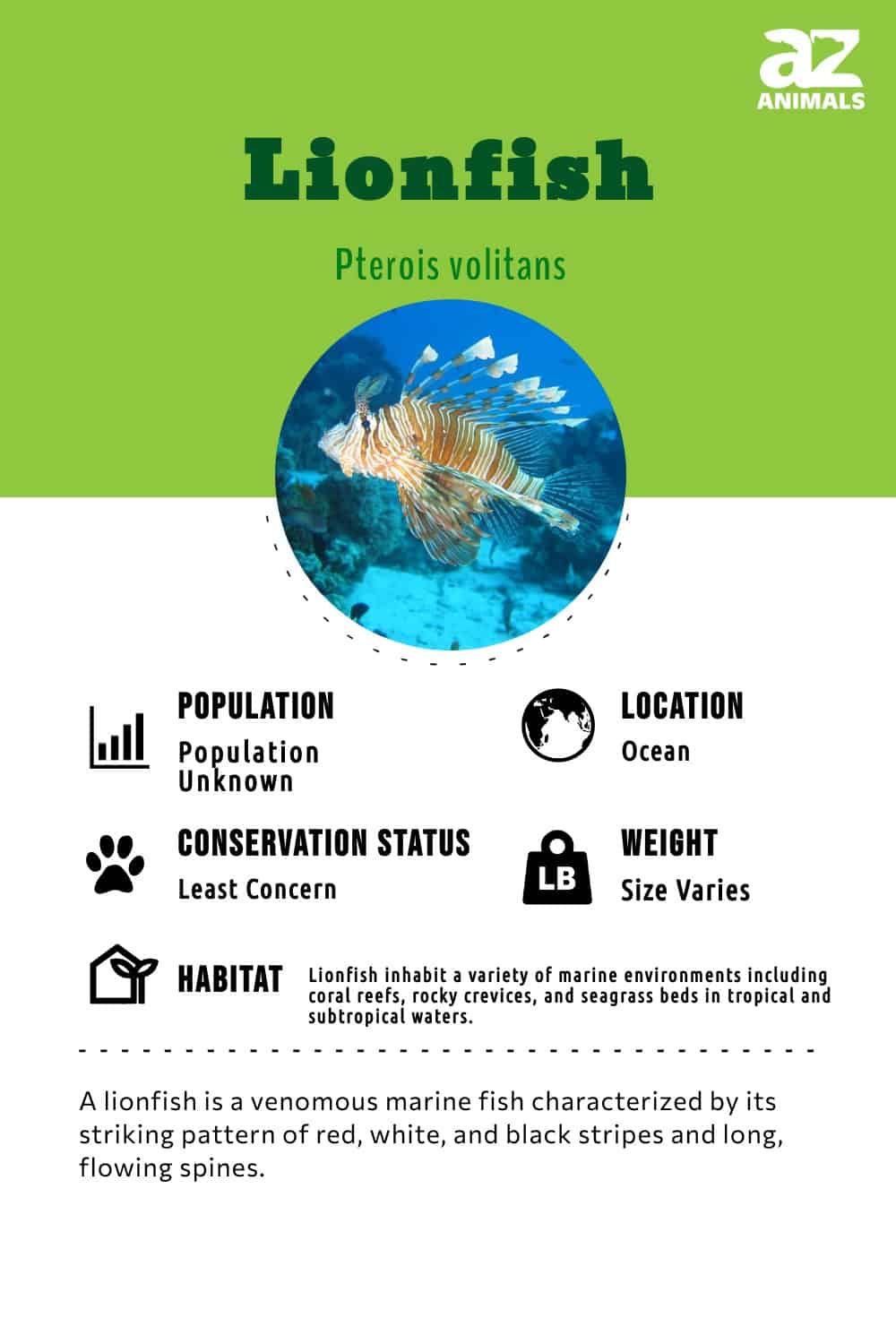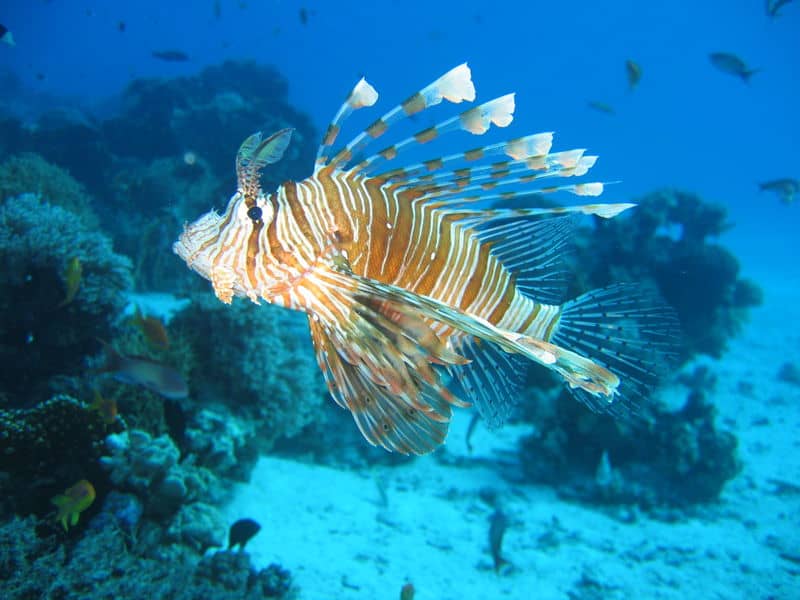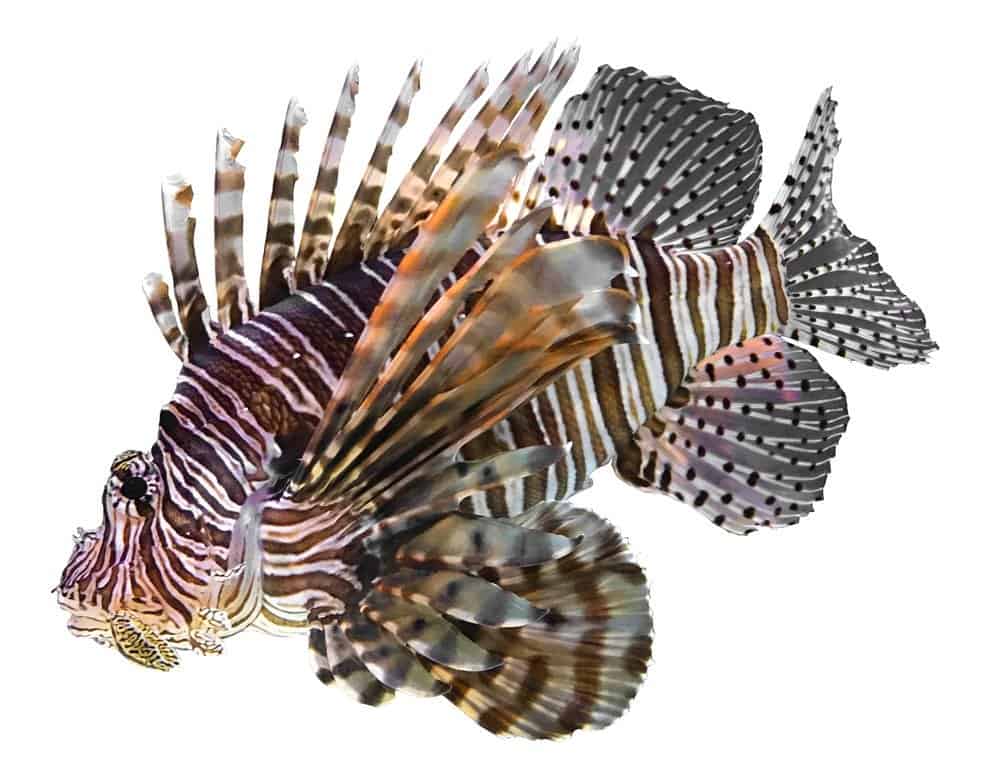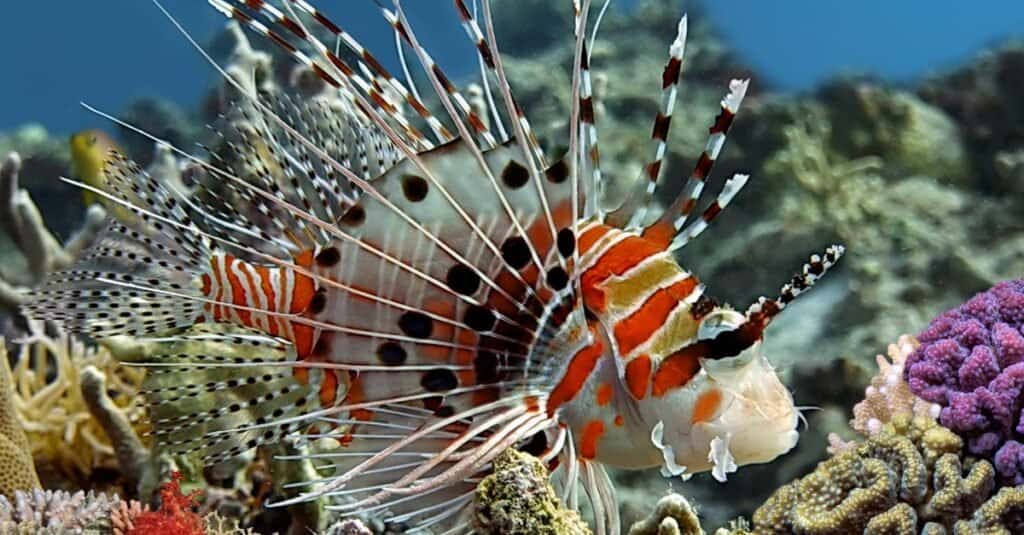Lionfish
Pterois volitans
Females can release up to 15,000 eggs at a time!
Advertisement
Lionfish Scientific Classification
- Kingdom
- Animalia
- Phylum
- Chordata
- Class
- Actinopterygii
- Order
- Scorpaeniformes
- Family
- Scorpaenidae
- Genus
- Pterois
- Scientific Name
- Pterois volitans
Read our Complete Guide to Classification of Animals.
Lionfish Conservation Status
Lionfish Facts
- Main Prey
- Fish, Shrimp, Crabs
- Distinctive Feature
- Striped body markings with long spines
- Optimum pH Level
- 8.1 - 8.4
- Habitat
- Tropical reefs and rocky crevices
- Predators
- Eels, Frogfish, Scorpion Fish
- Diet
- Carnivore
- Favorite Food
- Fish
- Common Name
- Lionfish
- Average Clutch Size
- 8000
- Slogan
- Females can release up to 15,000 eggs at a time!
View all of the Lionfish images!

Lionfish are a group of carnivorous fish species that are native to the Indian and Pacific oceans.
While there is plenty of diversity among the different species, all of them are characterized by striking skin color and pronounced venomous spines protruding from their body. The venom conveyed by their sting is a powerful deterrent to predators and is even a health concern for humans.
Several types of lionfish have become established off the coast of the United States and elsewhere in the Atlantic Ocean as invasive species that present a significant ecological threat.
3 Lionfish Facts

Lionfish “corner” their prey by using their pectoral fins, which resemble fans.
©Tobias Biehl – Public Domain
- Vicious venom: Their venom deters most predators and can cause serious symptoms in humans, especially young children. Lionfish are among the deadliest fish in the world.
- Active anglers: Some lionfish use the tentacle on their head to lure prey closer.
- Eating Lionfish campaign: Some conservation groups have actively educated the public and encouraged commercial consumption of lionfish as a way to control invasive species.
Evolution and Origins
A poisonous fish species called lionfish is native to the Indo-Pacific but has spread to other regions of the world as a result of human activity. Lionfish are indigenous to the warm, tropical waters of the Red Sea as well as the South Pacific and Indian Oceans (i.e., the Indo-Pacific region).
Long, vivid spines and a fin structure resembling a fan give these unusual fish their remarkable appearance. Lionfish developed in the warm, shallow waters of the Tethys Sea millions of years ago, during the Cretaceous period, which is when they first appeared.
These fish eventually evolved into other species, including the lionfish we are familiar with, by adapting to changing settings over time. Despite having a lengthy history, lionfish populations have recently increased dramatically in some places, raising worries about the effects they may have on regional ecosystems.
Classification and Scientific Name

This species’ spines have the ability to sting with venom.
Lionfish also go by many other names, including zebrafish and tasty fish. They are divided into two genera: Pterois and Dendrochirus. The scientific name of Pterois is thought to originate from the Greek word “pteron,” which means feather or wing.
The scientific name for Dendrochirus also has Greek origins and can be loosely translated as “having tree-like markings.” Both lionfish genera belong to the taxonomic family Scorpaenidae in the Actinopterygii class.
Other Names for Lionfish

Lionfish have spread to areas where they are not native.
The 12 species in the genus Pterois are the ones that are conventionally labeled as lionfish, while the 6 species in Dendrochirus are considered dwarf lionfish. Lionfish have many colloquial or common names, including firefish, turkey fish, butterfly-cod, zebrafish, and tasty fish.
Many of these names are typically used to describe a specific species. For example, the species P. miles is known as devil firefish, P. volitans is the red lionfish and D. biocellatus is called two spot turkey fish.
Species
With about 18 species across two genera, there is plenty of diversity in coloration and size among lionfish. However, all of them trace their origins to the Indo-Pacific region and are considered invasive elsewhere. Both the classic and dwarf varieties typically pursue a diversity of prey in relatively shallow coastal waters.
- Red lionfish: One of the two species responsible for the Atlantic invasion and one of the most studied types of lionfish.
- Hawaiian turkey fish: A cave-dwelling fish that with a small native range that is limited to the coastal waters around Hawaii.
- Bricked firefish: A dwarf species found along coastal regions of the South China Sea, including the Boso Peninsula and Japan.
- Red sea lionfish: A species only found around the Arabian Peninsula, particularly Jeddah, Saudi Arabia, and the Red Sea.
Here is a full list of lionfish species:
- Pterois volitans
- Dendrochirus barberi
- Pterois volitans
- Pterois russelii
- Pterois Mombasa
- Pterois volitans
- Andover lionfish
- Spot-fin lionfish
- Luna lionfish
- Devil firefish
- African lionfish, frill-fin turkey fish
- Clear-fin lionfish
- Plaintail turkey fish, soldier lionfish, or Russell’s lionfish
- Hawaiian turkey fish
Appearance

A female lionfish can produce over 2 million eggs annually.
©Erika Kirkpatrick/Shutterstock.com
With interesting combinations of brilliant colors and interesting patterns, lionfish certainly have a unique aesthetic. Their coloration combined with numerous spines gives them a striking visual display and is the main reason they are sought after as an aquarium species.
In their natural environment, these colors serve to warn potential predators that the fish has hazardous venom and is not a desirable target.
All lionfish are equipped with a collection of spines along the top of their body and most have spines protruding from their sides or rear as well.
Many species also have angling antennae that extend from their forehead that serves to lure prey closer before being eaten. In general, lionfish have a compact form with a thick body and shorter tail. Adult fish can range in length up to 18 inches, while some dwarf varieties only reach about 6 inches long.
Distribution, Population, and Habitat

Lionfish only emerge at night and are considered lionfish are nocturnal.
All lionfish species are native to saltwater environments and prefer to inhabit shallower waters less than 500 feet in depth. Some species linger around rocky coastlines or seek harbor in lagoons. Others seek sheltered habits like coral reefs and submerged wrecks that provide a rich hunting ground to satisfy their voracious appetite.
These fish have a vast natural geographic range, although individual species are typically confined to regional waters. The warm, tropical waters between Australia and China are rich in diversity and population. However, various lionfish species find their origin across most of the Indo-Pacific coast stretching from Japan to Madagascar.
Lionfish are a significant invasive threat to the Mediterranean, Caribbean, and Atlantic Oceans. Divers and ecologists began reporting occasional sightings off the coast of the United States in the 1990s. Within a few decades, population numbers exploded due to their fast reproductive rates and effective defense mechanisms. Total population numbers are unknown but are generally considered to be of least concern in terms of conservation.
Total population numbers for lionfish are unknown, but their resistance to predators and incredible reproduction rate means they are at low risk of endangerment. In fact, their ability to rapidly increase their numbers in new environments is a cause for concern for many endangered species around the entire Atlantic ocean.
Predators and Prey
Lionfish are voracious eaters and prey on all kinds of marine creatures. They are typically ambush predators that take an active role in surprising and cornering prey. Some species also propel water currents towards prey to disorient them and prevent escape. They also have few natural predators due to their poisonous spines, although there are a few carnivorous species that can eat them.
What eats lionfish?
Humans are actually one of the few species that successfully hunt and eat lionfish, although it’s not without its risks. Natural marine predators include moray eels, blue-spotted cornetfish, and several types of groupers. Other types of ocean predators, like sharks and Bobbit worms, may also be able to eat lionfish.
What do lionfish eat?

Spotfin lionfish (Pterois antennata) on a reef. Lionfish are known for their venomous fin rays, an uncommon feature among reef-dwelling fish along the American East Coast and the Caribbean.
©Vlad61/Shutterstock.com
These carnivores aren’t all that picky about what they eat. They are capable of decimating local populations of small fish species as well as various invertebrates and mollusks. Creole fish, yellowtail snappers, and shrimp are among the many possible items on their menu.
Reproduction and Lifespan
Lionfish have astounding reproductive capabilities, which only contribute to their ecological threat as an invasive species. Even though they can live for up to 20 years, they typically reach sexual maturity in less than one year. They are able to reproduce every few days and continue to lay eggs throughout the entire year. Some females have been reported to release more than 2 million eggs in a single year.
Fishing and Cooking
While lionfish don’t have a strong history as a menu item for humans, this has been changing in recent years. Since there are few natural predators for fish, conservationists and other organizations throughout the Americas have been advocating consumption of the fish as a means of population control. While fishermen do have to care about the sting of their spines, the venom does not impact the safety or taste of the meat when properly prepared.
Fish meat is actually considered to be quite good and suitable for regular consumption. Its flavor can be described as delicate and mild with a moist and tender texture. Its taste has also been compared to that of lobster and shrimp. Preparation often involves breading the meat to keep it from falling apart, although there are plenty of viable cooking methods. However, preparation should always involve careful removal of spines and applying enough heat to neutralize any toxins.
View all 98 animals that start with LLionfish FAQs (Frequently Asked Questions)
Are lionfish poisonous?
Lionfish spines convey venom to animals that touch them, creating an effective defense against the vast majority of predatory ocean animals. Their venom is a leading reason for their success as an invasive species since new ecosystems have few natural predators that are adapted to get around this mechanism. Their toxin can cause numerous health issues in humans, ranging from localized pain to digestive symptoms, and may cause a lethal reaction in small children or individuals with a sensitivity to the chemical.
Where are lionfish found?
Lionfish are found throughout coastal regions in the Indian and Pacific Oceans. Individual species are mostly localized to certain regions. Several species have also become prolific and successful invaders in the Caribbean and along the coast of North America.
Lionfish live exclusively in shallower waters with a depth of less than 500 feet. They tend to stay around rugged terrain, like coral reefs or lagoons, that helps them ambush and corner their prey.
Where did lionfish come from?
Lionfish come from the Indo-Pacific region, particularly the waters around Australia, Malaysia and other Pacific islands.
What happens if you get stung by a lionfish?
Lionfish stings can be incredibly painful and may also lead to dizziness, heartburn, indigestion or a host of other temporary symptoms. It can cause a lethal cardiac or respiratory reaction in people with an allergic sensitivity to the venom and very young children.
Why is the lionfish a problem?
The lionfish is a problem because it has devastating consequences on foreign environments and is very successful at invading them. Their venomous spines and high reproductive rate makes them a significant threat to prey species and a staunch competitor to other predators.
Are Lionfish herbivores, carnivores, or omnivores?
Lionfish are Carnivores, meaning they eat other animals.
What Kingdom do Lionfish belong to?
Lionfish belong to the Kingdom Animalia.
What phylum do Lionfish belong to?
Lionfish belong to the phylum Chordata.
What class do Lionfish belong to?
Lionfish belong to the class Actinopterygii.
What family do Lionfish belong to?
Lionfish belong to the family Scorpaenidae.
What order do Lionfish belong to?
Lionfish belong to the order Scorpaeniformes.
What genus do Lionfish belong to?
Lionfish belong to the genus Pterois.
What type of covering do Lionfish have?
Lionfish are covered in Scales.
What is the main prey for Lionfish?
Lionfish prey on fish, shrimp, and crabs.
What are some predators of Lionfish?
Predators of Lionfish include eels, frogfish, and scorpion fish.
What are some distinguishing features of Lionfish?
Lionfish have striped body markings with long spines.
What is the average clutch size of a Lionfish?
Lionfish typically lay 8,000 eggs.
What is an interesting fact about Lionfish?
Female Lionfish can release up to 15,000 eggs at a time!
What is the scientific name for the Lionfish?
The scientific name for the Lionfish is Pterois volitans.
What is the lifespan of a Lionfish?
Lionfish can live for 10 to 18 years.
What is the optimal pH for a Lionfish?
The optimal pH for a Lionfish is between 8.1 and 8.4.
How do Lionfish have babies?
Lionfish lay eggs.
What are the differences between scorpion fish and lionfish?
The main differences between a scorpionfish and a lionfish are that they belong to different evolutionary groups, utilize different hunting strategies, and inhabit different parts of the world.
Thank you for reading! Have some feedback for us? Contact the AZ Animals editorial team.
Sources
- National Ocean Service, Available here: https://oceanservice.noaa.gov/facts/lionfish-facts.html
- Smithsonian Magazine, Available here: https://www.smithsonianmag.com/science-nature/invasion-of-the-lionfish-131647135/
- Brittanica, Available here: https://www.britannica.com/animal/lionfish
- Sailors for the Sea, Available here: https://www.sailorsforthesea.org/programs/ocean-watch/lionfish-invasion
- Ocean Support Foundation, Available here: https://www.oceansupport.org/lionfish-information
- Wikipedia, Available here: https://en.wikipedia.org/wiki/Pterois

















